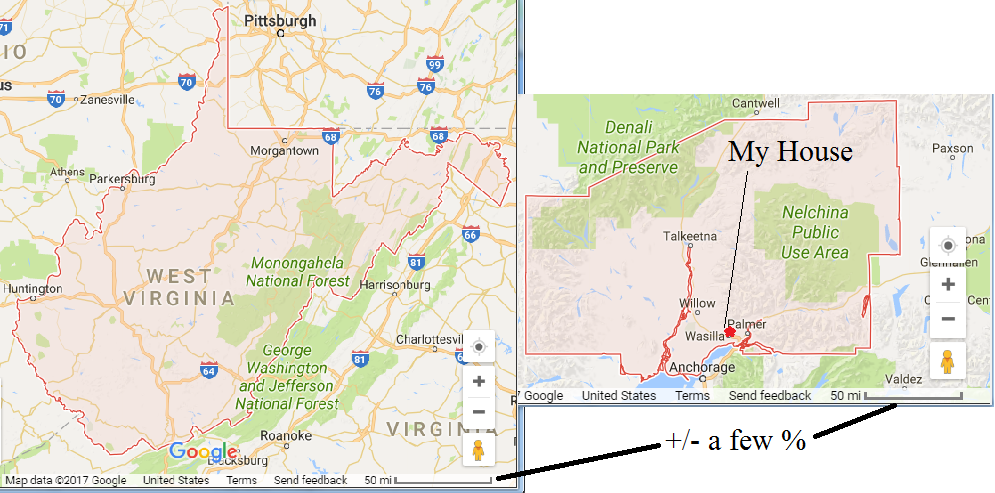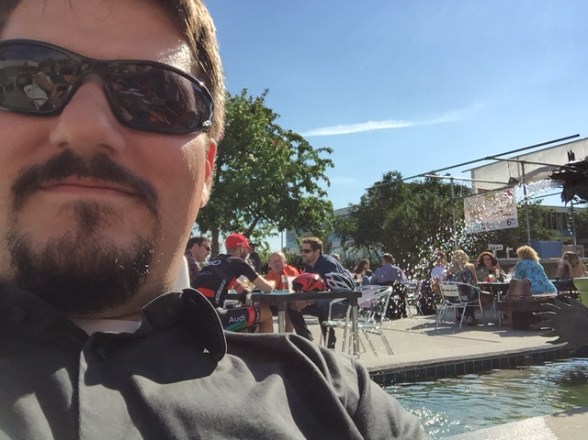[UPDATED!] You’ve found your way to post #2 of my series of articles on the Urban Alaskan, written for my non-Alaska friends, where I talk about how my day to day experience is exactly like yours, mostly, except for the moose and timezone and other stuff. If you want to catch up, you can see post #1 here.
I wanted to go into this post talking all about how my day to day life is exactly the same as anyone else in America, or at least close enough that it’s totally 100% relatable. I even got stuck in a lovely long traffic-jam this morning (do you see the line of traffic? It’s way off in the distance at the foot of the mountain) [As I update this, I didn’t get stuck in traffic today, but it’s been a problem most of the summer],

but as I approached work, thinking about how I was going to re-organize this post to talk about the mundanitude of the usual Urban Alaskan day, I passed a moose sauntering up the sidewalk on a road more or less smack dab in the middle of Anchorage. To be clear, this is a totally normal thing here, and it reminded me that, yes, actually, even Alaskan city life is a bit unique, but in that unique sort of way every place is. No matter where you’re from, there is some unusual aspect to your life that isn’t common elsewhere. But for whatever reason Alaska seems to just capture folks attention.
In any case, I can’t really answer the question posed by the title of this post without a bit of context. What I can say is that certainly not going to answer it in a single post. Being from Alaska is a sexy thing to be. It’s always an excellent ice-breaker, gives you infinite leverage to discuss everything Alaska, no matter how urbanly-myopic you might be. Being able to say “I’m from Alaska” will make you seem way cooler than you actually are. As I’ve already said, living in urban Alaska is about like living anywhere else in the continental US. For example, when I do my shopping at Target, there is a better than 50% chance that I will buy a coffee at the Starbucks inside. I think that’s a pretty typical thing for a middle-class American to do.
Before I keep going, I need to clarify one item, and this is one of those big difference items. My definition of ‘urban’ or ‘non-rural’ tends to be VERY different from most people in this country. When I say ‘rural’, I’m usually talking about a place that requires travel by aircraft or boat. In my mind ‘urban’ also includes places that in other parts of the country would be considered decidedly rural. Take my house for example. I regard myself as being an urban Alaskan but I’ve got six acres and our neighborhood does not look like what most folks picture when you say ‘suburban’. I’ve even heard someone describe our little chunk of land as an ‘estate’ given it’s size (That was like 15 years ago and I’m still laughing about it).
There are three main urban centers in Alaska, Anchorage/Mat-Su, Fairbanks, and Juneau/Douglas (I’ve also included Ketchikan in the map here because it’s designated as “non-rural” under subsistence rules). Some folks might also consider Kenai/Soldotna, part of the Anchorage/Mat-Su urban center, but I’m not going to argue that point just now. Or maybe ever. It doesn’t matter, both of those areas are a bit complicated.

I happen to live in Wasilla which about 30 road miles north of the state’s largest city and economic hub and population center, Anchorage. We haven’t got counties up here, we have municipalities and boroughs, all of which are large enough to beat up a small east coast state and take their lunch money.

Wasilla sits in a borough by the name of the Matanuska-Susitna Borough (Mat-Su for short or just ‘The Valley’ for folks in this region). It’s about size of West Virginia with a total population of about 100K (7% of the total state population). To get your mind around that number, if you flew every single one of us to Columbus, Ohio we’d all fit inside the Buckeye’s home stadium. Being that Wasilla is so close to Anchorage, you can’t really talk about living here without also talking about Anchorage. After all, many, many people living in Wasilla and our companion city, Palmer, work in Anchorage. Apart from being the state’s population center, the Municipality of Anchorage is geographically larger than Rhode Island and takes roughly two hours to traverse in light traffic when you hit all the lights green. It sports a population just shy of 300K. When combined, this region makes up roughly half of the state’s entire population.
Now you have a solid handle on the geography of where I live and the unusual distinction between urban and rural that I make, I feel like I can proceed, and I’ll keep the rest of this brief – I promise.
Last Saturday, we hopped in our car and drove about ten minutes up the road to Target for school supplies. Along the way, we were on paved roads the entire time, didn’t pass a single moose or bear, I don’t recall seeing a single dog musher, and absolutely none of the houses we passed were igloos. No small airplanes swooped down to the roadway in for a quick landing [Update: Highway landings have happened on at least two occasions this summer as I write this], and the temperature hung right at about seventy degrees. I’ve been to Target stores in Maryland, Ohio, and Minnesota, and the one thing I can say about them is that they’re all about the same. When we were done with our school shopping, which did not involve extreme winter gear or specialized Alaska school stuff, we got our groceries at Fred Meyer (Kroger). I’ve never visited one of these outside of Alaska, but I understand they all have about the same layout across the pacific northwest. So, you can bet that was pretty normal. After that, a quick stop at JoAnn Fabric for some knitting stuff and home. As we drove across Wasilla, we passed the usual fast-food restaurants and box-stores you might expect to find in a town of this size – Carl’s Jr, Taco Bell, Panda Express, Walmart, PetCo, Famous Footwear, Verizon, iHop, Lowes and Home Depot, more than one Starbucks, and a bunch of others. (Pardon the image, it’s from a several years ago in fall, but you can see some familiar logos in there)

I think the most remarkable thing about the whole routine trip, from the perspective of someone living outside (yes, we bloody call you outsiders), is that I bought some Navel Oranges for $2.59/lb. If I don’t miss my guess (Because I found it on USDA website), the national average is closer to $1.50/lb. A similar cost difference is true for apples, onions, berries, and bread. It’s true that living in urban Alaska is more expensive than elsewhere, but not horrible – no worse than living inside a big city. At least not as far as consumer goods are concerned. [Update] Yesterday I went down to the Verizon store and bought a new iPhone 12 and set up the 3rd of our children with their first phone. The prices we pay here are exactly the same as anywhere else in the country.
My point is that day-to-day, my life here is really not so different from the average American.
Next Up: What’s the weather like?


Enjoyed it, Dave. Why not wait until Iphone 8 comes out in a couple months?
LikeLiked by 1 person
Price tag is expected to be 1200-1500. I might wait tho.
LikeLike
Don’t forget about the awesome all- night sunshine, until about a month after the Solstice, at which point you freak out and realize it’s dark at midnight and then a week or so later it’s dark at 11. (Next thing it’ll be dark at 4pm!) The exponential loss and gain of daylight definitely triggers some weird productivity behaviors in folks out here (still no borough or municipal for these”rugged individualists”)- must cut fire wood, expose maximum whiteness to sun for last gasp Vit D, pick berries, smoke fish, kill large mammals. Great idea for a series Dave, will be forwarding.
LikeLiked by 1 person
It is true. nothing motivates me to smoke a couple dozen fish like waking up at midnight to realize it’s dark. I was going to do a whole post on daylight.
LikeLike
[…] You’ve found your way to post #3 of my series of articles on the Urban Alaskan, written for my non-Alaska friends, where I talk about how my day to day experience is exactly like yours, mostly, except for the moose and timezone, you can get to the last post here. […]
LikeLike